#Lord Ganesha And Lakshmi
Explore tagged Tumblr posts
Text
#Laxmi Ganesha#God Laxmi Ganesh#Laxmi Ganesha Murti#Ganesh Laxmi In Silver#Silver Laxmi And Ganesh#Laxmi Ganesh Silver Murti#Silver Ganesh Laxmi Murti Price#Silver Ganesh And Lakshmi Price#Laxmi Ganesh Murti In Silver Price#Lord Ganesha And Lakshmi#Laxmi Ganesh Murti Price#Silver Ganesh And Laxmi Murti#Laxmi Ganesh Murti Near Me#Buy Online Laxmi Ganesh
0 notes
Text
Lord Sri Vishnu and other Gods in Vaikuntha
#vishnu#lord vishnu#lakshmi#goddess lakshmi#hanuman#lord hanuman#brahma#lord shiva#adishesh nag#lord garuda#tumburu#lord ganesha#devarshi narad
0 notes
Text
Buy Ganesha Laxmi Idol & Krishna Radha Idol for Prosperity Spiritual Bliss
Invite blessings of abundance and prosperity into your home with a Ganesha Laxmi idol. This divine union represents Lord Ganesha, the remover of obstacles, and Goddess Lakshmi, the bestower of wealth and fortune.
A Ganesha Laxmi idol, meticulously crafted with reverence, symbolizes the harmonious combination of wisdom and material abundance. Displaying this idol in your home creates an auspicious ambiance that attracts prosperity and success.

Embrace the divine presence of Ganesha and Lakshmi as you seek their blessings for a fulfilled and prosperous life. Let their energy guide you towards abundance, harmonious relationships, and spiritual fulfillment. Embrace the divine union and experience the transformative power of Ganesha Laxmi in your life.
Discover the epitome of divine love and devotion with a Krishna Radha idol. This sacred representation of Lord Krishna and Radha signifies the eternal bond between the divine and the devotee.
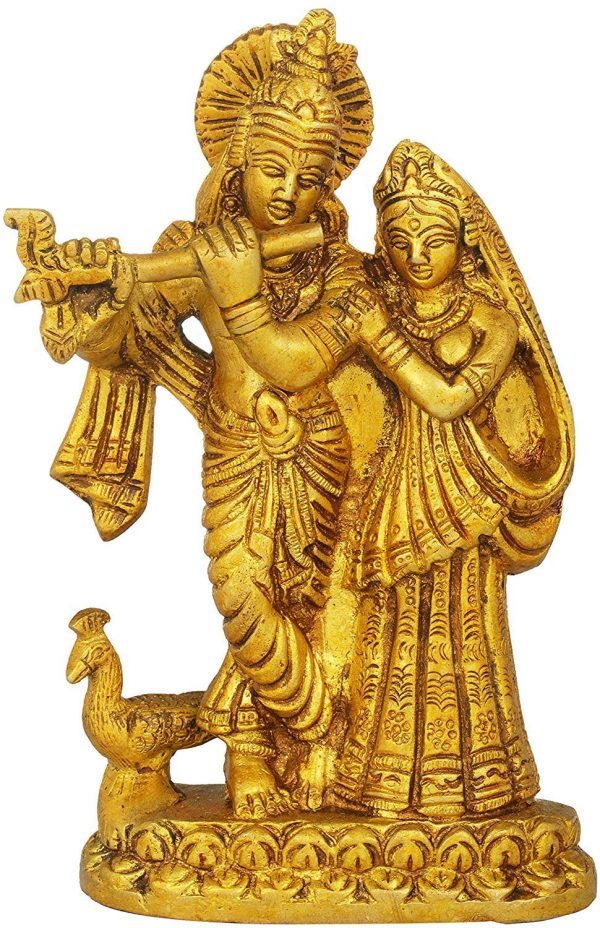
Crafted with exquisite artistry, a Krishna Radha idol captures the essence of their divine love story. The playful and enchanting presence of Krishna, along with the devotion and beauty of Radha, creates an atmosphere of spiritual bliss.
By welcoming a Krishna Radha idol into your home, you invite the energy of unconditional love, harmony, and spiritual union. Immerse yourself in their divine grace, experience the blissful devotion, and let their divine love guide your spiritual journey.
#krishna radha statue#krishna radha idol#shruti box online#brass buddha statue#buddha statue online#lakshmi statue#lord krishna idol#lord ganesha statue#lord ganesha idol#tibetan singing bowls#ganesha laxmi idol
1 note
·
View note
Text
Deities in Hinduism 🛕
Hinduism is the largest religion in the Indian subcontinent, and the third largest religion in the world. Hinduism has been called the "oldest religion" in the world, and many practitioners refer to Hinduism as "the eternal law" (Sanātana Dharma). The faith is described by some to be monotheistic, where all deities are believed to be forms of Brahman, the Ultimate Reality, as popularised by the Advaita philosophy.
"A Hindu can choose to be polytheistic, pantheistic, monotheistic, monistic, even agnostic, atheistic, or humanist."
1. Lord Vishnu

Vishnu is the god of Preservation, the great maintainer who often appears in various incarnations (avatara) to provide salvation for humanity. Some of his best-known avatars, who are tremendously popular and beloved throughout Hindu India, are the gods Krishna and Rama.
2. Lord Shiva
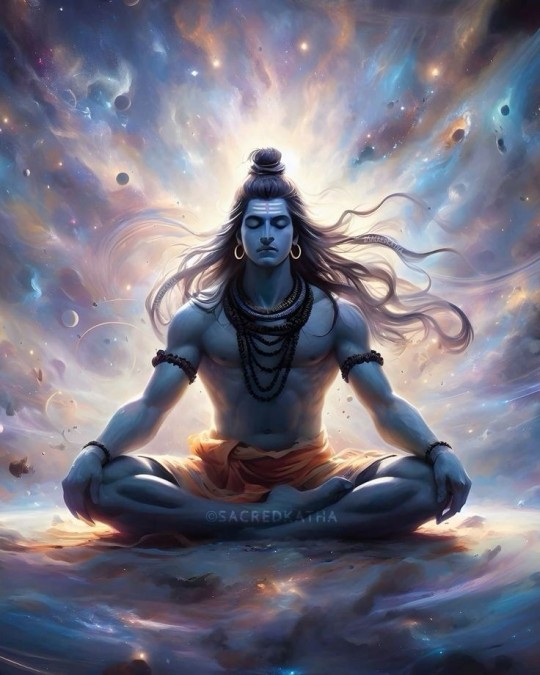
Shiva holds one of the most prominent roles in Hinduism as the god of destruction. He is one of the three most important gods, alongside Brahma (the creator) and Vishnu (the preserver). The sect of Shaivism holds that Shiva is the Supreme Being which all other gods are aspects of.
3. Maa Kali
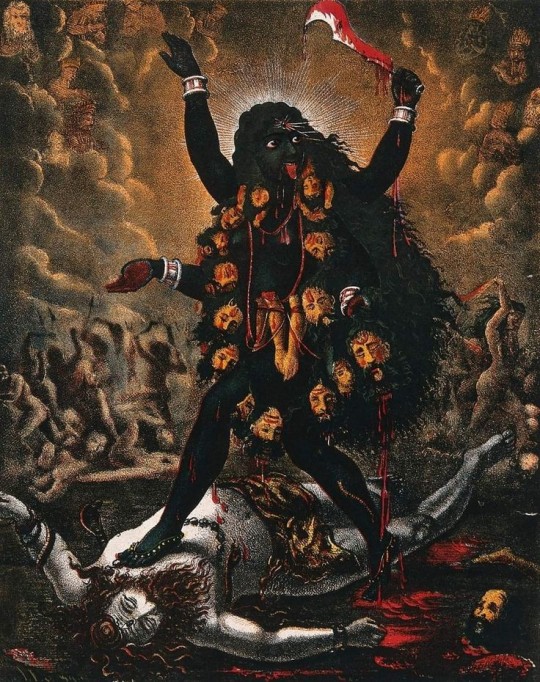
Kali is the Hindu goddess of death and rebirth, she expresses the dual nature of the destruction that must come before new beginnings, and of the strength of the female power which can sometimes do what the man cannot. She is also the goddess of time.
4. Maa Durga
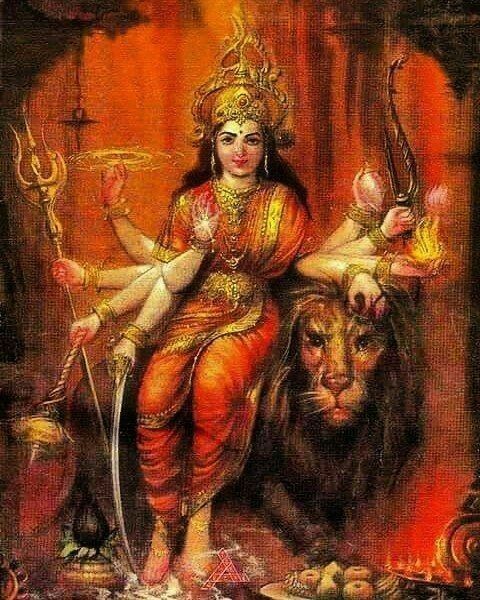
Durga, goddess of Shakti - the divine positive feminine energy and focus of festival celebrations. This very elegant bronze figure of Devi (goddess) Durga - is an attractive and prominent figure and a principal deity in Hinduism.
5. Lord Ganesha

He is widely revered, more specifically, as the remover of obstacles and bringer of good luck; the patron of arts and sciences; and the deva of intellect and wisdom. As the god of beginnings, he is honoured at the start of rites and ceremonies
6. Maa Saraswati

Saraswati is the Hindu goddess of knowledge. She is associated with wisdom, music, art, and learning. She is one of the three main goddesses of Hinduism, along with Lakshmi and Parvati. Together the three goddesses are called the Tridevi.
7. Maa Lakshmi

Lakshmi is the Hindu goddess of wealth, good fortune, happiness, youth, and beauty. She is the wife of Vishnu, the god that sustains the universe; he makes sure the universe stays together while Shiva, the destroyer, rips it apart.
#tarot reading#tarot spread#tarot cards#tarot blog#tarot#pick a card#pick a pile#tarot and astrology#tarot community#tarotblr#tarot asks#tantra#hinduism#hindublr#sanatandharma#tarot justice#tarot journal#the divine masculine#tarot divination#spiritual disciplines#future spouse#kashmiri hindus#channeled message#tarot blr#tarot beginner#future spouse reading#indian goddess
243 notes
·
View notes
Text

Ganesha the Gatekeeper Ganesha is said to be the remover of obstacles, which he is most energized to accomplish on Ganesh Chaturthi, his special day of the year in the Vedic calendar. Sri Ganesha is one of the oldest and most revered Hindu deities, as well as the most distinctive. His head of an elephant, enigmatic stories and rich symbolism make him recognised worldwide. But what is the hidden truth behind his mystic image? Few seem to know. Great yogis know Sri Ganesha as the lord of the universe, the underlying cosmic intelligence that links us to the supreme reality beyond all name and form. Ganesha and Shakti Ganesha is also the son of Shakti as Devi Parvati. Only Ganesha can take the supreme Shakti energy and direct it along the necessary currents for its complete manifestation. Ganesha dwells in the Muladhara, or root chakra, which rules over the earth element and holds the Kundalini Shakti, our individual power of transcendence. Ganesha provides us with the stability to wield the Shakti force that rises out of the earth and takes us to the infinite light. His mantra GLAUM aids in the stabilization of the Muladhara. OM GAM GLAUM Ganeshaya Namah! Ganesha is the unity of Shiva and Shakti, holding the highest awareness of Shiva while displaying all the powers of Shakti. His two consorts are Siddhi, the power of accomplishment, and Buddhi, the power of knowledge. On Diwali, as Siddhi he is combined with Lakshmi and the mantra SHRIM (Shreem) and Sarasvati and the mantra AIM, who reflect these two forces. Ganesha is dear to all the Goddesses. Ganesha is said to be the remover of obstacles, which he is most energised to accomplish on Ganesh Chaturthi, the main day of the year for his worship, which usually occurs late August into September. Surrender to the cosmic intelligence of Ganesha and he will manifest the best of all possibilities without your need to worry, turning all difficulties into grace. These are but a few glimpses of the yogic secrets of Sri Ganesha. Yet if you are willing to join his group of ganas, which is your true family, Ganesha will lead you to unqualified bliss and the combined presence of Shiva and Shakti. Jai Sri Ganesha! ~Vamadeva Image art: Ganesha the Gatekeeper by Mahaboka
8 notes
·
View notes
Text
FINALLY!!! THE TIME TO CELEBRATE DURGA PUJA HAS COME!!!

This puja or worship of the Ten-Handed Goddess, Goddess Durga and her children, celebrates victory of good over evil and also represents womenhood.
This is for people who don't know about this
The elephant God is Lord Ganesha, the God of Wisdom, Good luck and Removal of Obstacles. His vehicle is a mouse.
The Goddess wearing a pink saree is Goddess Lakshmi, the Goddess of Wealth and beauty. Her vehicle is an owl.
The Goddess with white skin is Goddess Saraswati, the Goddess of Arts, Music and Education. Her vehicle is a swan.
The God with black hair is Lord Kartik, the God of War. His vehicle is a peacock.
The Goddess in the middle with ten hands is Goddess Durga. She is one of the forms of the Supreme Goddess, Mahamaya, also known as the Divine Universe. She was created by all the Gods of heaven to defeat the demon, Mahishasur, and all of the Gods gave her each weapon, including her vehicle. Her vehicle is a lion.
The lion is her vehicle.
The demon who is here is Mahishasur. He's the demon who was really powerful that he conquered heaven but was killed by Goddess Durga in the process.
This festival is celebrated not only among Hindus but also among different religions and people from all over the world.
#durgadevi#durga puja#navratri#navratri 2024#devi durga#hindu#goddess durga#durgamaa#durga#durga pujo
4 notes
·
View notes
Text
The Timeless Beauty of Stone and Marble Handicrafts
Handicrafts have long been an integral part of India’s rich cultural heritage, and stone and marble handicrafts are among the most admired forms of craftsmanship. These pieces blend tradition, artistry, and skilled workmanship to create stunning decorative and utility items. Whether used for home décor, religious purposes, or gifting, stone and marble handicrafts offer a touch of elegance and timeless appeal.
At AS Handicrafts, we take pride in offering a wide range of exquisitely crafted stone and marble handicrafts, perfect for enhancing any space with their beauty and uniqueness.
Stone Handicrafts: A Blend of Art and Durability
Stone handicrafts are known for their durability and intricate detailing. Skilled artisans carve natural stones into breathtaking sculptures, decorative pieces, and everyday essentials, making each piece a work of art.
Popular Stone Handicrafts at AS Handicrafts
✔ Decorative Sculptures – Intricately carved figurines of animals, deities, and abstract art pieces. ✔ Religious Idols – Beautiful stone idols of Hindu gods and Buddha statues for temples and home altars. ✔ Stone Inlay Work – Exquisite tabletops, coasters, and panels with intricate stone inlay patterns. ✔ Garden Décor – Elegant stone fountains, planters, and decorative garden pieces.
Each stone handicraft is crafted with precision, ensuring that it reflects India’s rich artistic tradition while maintaining strength and durability.
Marble Handicrafts: Symbol of Elegance and Luxury
Marble handicrafts have been admired for centuries for their sophistication and aesthetic appeal. Used in everything from architecture to home décor, marble’s smooth finish and natural veining make it a favorite material for artisans.
Popular Marble Handicrafts at AS Handicrafts
✔ Marble God Idols – Finely crafted idols of Lord Ganesha, Krishna, and Lakshmi, perfect for worship. ✔ Marble Home Décor – Stunning vases, candle holders, and decorative plates. ✔ Marble Utility Items – Elegant trays, pen holders, jewelry boxes, and coasters. ✔ Marble Inlay Table Tops – Luxurious handmade tables with intricate inlay work.
At AS Handicrafts, our marble handicrafts are designed to add a touch of grandeur to any space while being functional and durable.
Why Choose AS Handicrafts?
✔ Authentic Craftsmanship – Each piece is handcrafted by skilled artisans using traditional techniques. ✔ High-Quality Materials – We use premium stone and marble to ensure durability and elegance. ✔ Customization Available – Get personalized designs to suit your preferences. ✔ Affordable Prices – Exquisite handcrafted pieces at competitive rates. ✔ Secure Shipping – Safe and timely delivery across India and internationally.
Conclusion
Whether you’re looking for intricate stone handicrafts or elegant marble handicrafts, AS Handicrafts offers a collection of handcrafted masterpieces that celebrate India’s rich artistic heritage. These timeless creations not only enhance the beauty of your space but also reflect skilled craftsmanship that has been passed down through generations.
Explore the stunning range of handcrafted stone and marble artifacts at AS Handicrafts and bring home a piece of art that lasts a lifetime!
2 notes
·
View notes
Text
Bommala Koluvu for Navaratri
Navaratri (Nava = nine, ratri = night), followed by Dussehra, is one of my favorite festivals of the year. I have many memories associated with it. Since my early teenage years, my mother and I would arrange a ‘Bommala Koluvu’ (Bommalu = dolls/idols, koluvu = arrangement) at home. Although it took almost a whole day to set up the steps and the idols/dolls, it was worth it. We would perform Pooja and other rituals in front of the Koluvu for all 10 days.
Note: Usually, in the culture that I come from, ‘Bommala Koluvu’ is observed during the festival of Sankranti but it can be observed during Navaratri and Deepavali, as well. My mother did this for both Sankranti and Navaratri.
Normally, people have the steps pre-built so that they don’t have to be arranged each for each festival it is used for. However, in our home, the steps were arranged differently. My mother did want to be restricted by the uniform size of the steps, which she would be if she had them built. She, instead, kept a few of our old furniture, like center tables, side tables and some cardboard boxes and used them specifically for the Bommala Koluvu. My mother and I would then cover the steps with a white or off-white cloth so the dolls would show up. We had almost 5 or 6 large moving boxes full of the dolls we would use to arrange on the steps. The set up of the steps and the white cloth would take most of our time. Arranging the dolls was the easy part.
What is the meaning behind this tradition?
The significance behind this tradition is that it pays homage to Goddess Mahishasura Mardhini (an avatar of Goddess Durga) who fought an epic battle against the demon, Mahishasura. It is Her victory that is celebrated during Navaratri. Another meaning behind the Bommala Koluvu is to tell multiple stories from South Indian mythology. It can range from scenes from Ramayan, Mahabharat, Srimad Bhagavatam and Krishna Leela. Some modern arrangements have specific themes like Sri Krishna Leela which focuses on stories ranging from Krishna’s birth to his marriages.
One of our family friends once did a Lord Ganesha themed Bommala Koluvu. In our home, we arrange a Vrindaavan on one side which shows all of Lord Krishna’s childhood. On the other side, we would arrange Kailasam (Lord Shiva’s abode) and in the middle we would arrange seven steps where each step would be dedicated to a Hindu God. For example, the first step would be for Goddess Durga and her avatars., the second step for Ashta Lakshmi (Ashta = 8), the third step for Lord Vishnu, and etc.
The best part of this tradition is that you can be as creative as you like. There are no rules on how the dolls should be arranged. And there are no restrictions as to what kind of idols and dolls you want to put in your Bommala Koluvu. You can even include some of your show pieces to make it look even more pretty!
Cultural Aspect
Bommala Koluvu is a great way to teach young children about our ancient culture, traditions, customs, mythology and the Puranas. It is also a creative of storytelling with live visuals. When dolls/idols are arranged this way, kids will be curious to learn more about each character and scenario being depicted. Plus, it also gives kids a chance to participate in the worship of Goddess Durga.
Social Significance
In the past, Hindu families were very orthodox which meant that women were did have the time to step out and catch up with friends. Moreover, some women were not permitted to leave the house as well.
The best part about Bommala Koluvu is that whoever is hosting invites friends, relatives, neighbors and so on. This is my favorite part because it meant that all our friends and relatives from all over California used to come over to our home and spend the whole night catching up with each other. This tradition ensures that friendships become stronger and helps women maintain their friendships since they can get caught up in their personal lives.
Economic Significance
India is an agricultural country where traditions like Bommala Koluvu and agriculture are related. Back in the day, the idols, dolls, and other items featured in a Bommala Koluvu were made with clay, wood, wax, glass, stone, etc. and were painted with natural paints. India is also home to many traditional handicrafts such as terracotta, Kondapalli, cloth dolls and more.
By purchasing these handcrafted items for Bommala Koluvu, the artists are encouraged to make more of them each season. All of the idols we have a home are made of clay, glass, and wood. We also have Kondapalli Bommalu (dolls) that have been passed down from my great grandmother. Another perk to purchasing these handcrafted, natural items is that they are eco-friendly!
Although arranging the dolls was tiring, catching up with friends, relatives and neighbors was made all the hard work worth it. Plus, there would a lot of leftover good food which we would eat for the next couple of days.
I hope you all enjoyed getting to more about this fun little tradition! Comment down below about a tradition you follow at your home for Navaratri!
~ The Saffron Muse
3 notes
·
View notes
Text
✨ Happy Dhanteras! ✨

As we celebrate the arrival of prosperity and good fortune, may this auspicious day bring health, wealth, and happiness into our lives. Let's cherish this Dhanteras with love, gratitude, and blessings from Goddess Lakshmi and Lord Ganesha. 🌸🕉️Wishing everyone a joyous and prosperous Dhanteras! 💫
#Dhanteras#Prosperity#FestivalOfWealth#RaisaaJewels#Blessings#HappyDhanteras#Dhanteras2024#SilverJewellery#FashionJewellery#WealthAndHappiness#FestiveVibes#DhanterasBlessings#Festivals#India#SterlingSilverJewellery
2 notes
·
View notes
Text
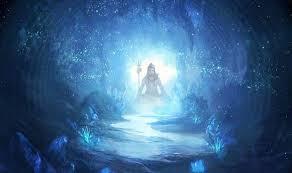
SIGNIFICANCE OF LORD SHIVA
by Maha Yogi Paramahamsa Dr. Rupnathji
Shiva is the experiencer and the highest object of experience. Shiva is the goal of Sadhana. There is nothing apart from Shiva. There is nothing other than Shiva. Whatever there is, is Shiva. There is nothing, which is not Shiva. There is no place, which is not Shiva. There is no time, which is not Shiva. To be aware of this is to be aware of Shiva.
Shiva (Sanskrit: Śiva, lit. the auspicious one) is one of the principal deities of Hinduism. He is the supreme god within Shaivism, one of the three most influential denominations in contemporary Hinduism.
Shiva is "the transformer" within the Trimurti, the Hindu trinity that includes Brahma and Vishnu. In Shaivism tradition, Shiva is the Supreme being who creates, protects and transforms the universe. In the goddess tradition of Hinduism called Shaktism, the goddess is described as supreme. A goddess is stated to be the energy and creative power (Shakti) of each, with Parvati the equal complementary partner of Shiva, Lakshmi, Vishnu and Saraswati of Brahma.
At the highest level, Shiva is regarded as formless, limitless, transcendent and unchanging absolute Brahman, and the primal Atman (soul, Self) of the universe. Shiva has many benevolent and fearsome depictions. In benevolent aspects, he is depicted as an omniscient Yogi who lives an ascetic life on Mount Kailash as well as a householder with wife Parvati and his two children, Ganesha and Kartikeya. In his fierce aspects, he is often depicted slaying demons. Shiva is also known as Adiyogi Shiva regarded as the patron god of yoga, meditation and arts.
Shivaism is essentially a nature religion, through ritual, offering alignment and coordination with subtle beings and supernatural forces. Shiva rules magic and the occult. Shiva is the god of the left hand path. The dark, lunar path of Tantriks: of the ritual use of sex, wine, and meat…of intoxication and ecstasy.
Shiva is a protector of those on the fringes of society, of everything chaotic, and dangerous, the unexpected and un-explainable. He is god of the humble (shudras), outcasts and criminals. A protector of animals and trees.
Shiva’s son Ganesha, is the lord of the ganas…the nature spirits: gnomes, goblins, gremlins and z, (smaller more focused devas, that abound in every aspect of nature.) Ganesh is universally, invoked first in any ritual, to propitiate the spirits of the earth, before calling forth the heavenly gods.
The main iconographical attributes of Shiva are the third eye on his forehead, the serpent around his neck, the adorning crescent moon, the holy river Ganga flowing from his matted hair, the trishula (trident) as his weapon and the damaru (drum). Shiva is usually worshiped in the form of Lingam. Shiva is a pan-Hindu deity, revered widely across India, Nepal, Sri Lanka and Bali.
8 notes
·
View notes
Note
Hey, I saw that flower post with the Hindu Pantheon. Just wanted to say Goddes Saraswati, the goddess of wisdom, is always shown as sitting on a lotus. Lord Vishnu as well, Lord Ganesha, are usually shown holding a lotus flower as well. Specifically, hibiscus flowers are saved for Lord Ganesha. We also use orange and yellow marigolds. Mogra or Arabian Jasmine specifically is worn in the hair in the form of a gajara, and it smells amazing.
Oh! You must be referring to that lovely artwork of Shiva, his family, and Vishnu holding many flowers! It was done by @evansuvamp
Her art is AMAZING 💜
That’s very interesting to hear! I’ve seen images before of goddesses like Saraswati, Lakshmi, Parvati, and male gods sitting on lotuses. They looked so divine! ✨
I didn’t know that Ganesha’s special flower is hibiscus. Also the many types of flowers you told me that you guys wear in your hair must be so colorful and lovely to look at~ 🥰
Thank you for informing me!
6 notes
·
View notes
Text
Unlocking Wealth: Long-Term Investments with Kundan Refinery's Coins

A long-term investment in gold or silver is the best way to secure your future. Gold or silver coins and bars, also known as bullion wealth, give a sense of safety and satisfaction as your lifestyle depends on financial stability. Gold investment minimizes the possibility of loss during inflation. To invest in the pure and certified bullion coin, Kundan Gold Coins Refinery is the name you can trust. Before moving on to why Kundan stands as the most trusted gold coin refinery, let's figure out the significance of gold and silver bullion.
Gold and silver coins: Tangible and Low-risk Investment
Gold or silver refers to coins or bars with a minimum purity of 99.5. The coins are minted, tested, and stamped with a certificate for their purity assurance. Besides the lustre and durability, the prominent reason for investing in gold coins is their increasing value. You can attract an impressive return on such an investment that involves low risk and complexities. Before buying gold as an investment, analyze the past and current gold rates and future probabilities.
Top reasons to make a long-term investment with Kundan Refinery
When you invest in Kundan coins, you get authentic and purest gold along with several after-purchase benefits. The following are the reasons for choosing the Kundan refinery for investment;
BIS Hallmarked coins: Distinguishing between pure and artificial gold can be challenging for the layman. If you want to avail the best rates for gold as an investment, you should go for certified gold from a reputable source. Kundan gold and silver are tested and approved by the Bureau of Indian Standards for its authenticity. All our products are stamped with purity detail, Hallmark center information, weight, etc.
After-purchase service: Kundan Refinery offers several after-purchase services like lifetime j 100% buyback policy for all Kundan products, including Kundan gold coins. You also get free shipping and the best customer support by trusting Kundan Refinery.
Diverse range and design: Kundan's 22K to 24K gold coins and bars have 916 to 999.9 purity. Our coins weigh from 0.25 grams to 11.66 grams and bars up to 20 grams. Our coins and bars come to reflect the impressive carvings of Lord Ganesha, the Kalpataru tree, Goddess Lakshmi, Tola, Queen, etc.
Market standard pricing: Kundan Refinery is known for its fair pricing policy. We keep the pricing details transparent with our customers and provide them with detailed bills with pricing breakdowns. You can shop for gold or silver coins and bars in various budget ranges at the Kundan refinery.
100% Buyback policy: A buyback policy is the best part of investing in gold coins for the flexibility of elevating your investment later. Kundan's gold comes with a 100% lifetime buyback policy. Kundan refinery offers 99% of the gross weight adhering to the current gold rates. You only need an original bill and certificate to get fair rates on gold exchange or buyback.
Wrapping up
Kundan gold coins and bars are not just auspicious symbols; they carry profound meanings. While gold or silver coins are precious gifts for their timeless glory, alluring aura, faith, and traditional values, they are excellent investment options for high value and safety. Check out our meticulously designed gold coins to invest in Kundan coins.
2 notes
·
View notes
Note
If you get this, answer with 3 random facts about yourself and send it to the last 7 blogs in your notifications, anonymously or not! Let's get to know the person behind the blog
Three more random facts about me? HaHaHa. Okay, let me think...
I was raised in a haunted house. Every family member saw the ghost at the end of a hallway near my parent's bedroom door. But here is the strange thing-- It was a new house that we watched being built and we were the first owners! So who was the ghost?
I have been blessed by a holy elephant named Lakshmi at the Manakula Vinayagar Temple, dedicated to Lord Ganesha in Pondicherry, India.
I have meditated at the Chichén Itzá pyramid known as the Temple of Kukulcán (El Castillo) in Mexico.
6 notes
·
View notes
Text
Diwali 2023: The Date, Time, Muhurat, and Significance of the Six-Day Festival of Lights
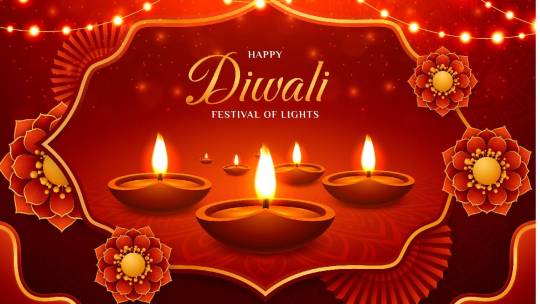
Diwali, also known as Deepavali, is a widely celebrated festival in India and by Indian communities around the world. It is known as the "Festival of Lights" and typically lasts for six days. Diwali symbolizes the triumph of light over darkness and good over evil.
During this festive period, people decorate their homes with oil lamps, candles, and colorful rangoli designs. Fireworks and firecrackers light up the night sky, adding to the joyous atmosphere. Families come together to exchange gifts, share delicious sweets, and offer prayers to deities like Lord Ganesha and Goddess Lakshmi for prosperity and well-being.
One of the significant customs of Diwali is the cleaning and renovating of homes, signifying the removal of negativity and the welcoming of positivity. It is a time for forgiveness, reconciliation, and strengthening of bonds with loved ones.
Overall, Diwali is a time of joy, unity, and spiritual reflection, making it one of the most cherished and widely celebrated festivals in India.
HAPPY AND SAFE DIWALI !!
#diwali#diwali 2023#deepavali#celebrations#diwali date#festival#traditions#indian festival#festiveseason#festive#deepawali#diwali significance#diwali celebration
2 notes
·
View notes
Text
Enhance Your Home Decor to Welcome Maa Laxmi with Grace
In the rich tapestry of Indian culture, the festival of Diwali holds a special place. Diwali, also known as the Festival of Lights, is celebrated with great enthusiasm and devotion. It is a time to welcome Goddess Lakshmi, the deity of wealth and prosperity, into our homes. To make this festival even more special, we can enhance our home decor to create a warm and inviting ambiance that welcomes Maa Laxmi with grace.

Here are some creative ways to elevate your home decor this Diwali and create a serene atmosphere that will surely attract blessings from the goddess of wealth.
Illuminate with Diyas and Candles
Lighting plays a significant role in Diwali celebrations. Traditionally, diyas (oil lamps) are used to light up homes. You can place these around your house, especially near the entrance and in the temple area, to symbolize the triumph of light over darkness. You can also incorporate scented candles in beautiful holders to add a modern twist to the tradition.
Rangoli Art
Rangoli is an art form where intricate patterns and designs are created on the floor using colored powders, flower petals, and other materials. This not only adds a visual appeal to your home but is also considered an auspicious tradition. You can experiment with various designs and colors to create a vibrant and welcoming atmosphere.
Flower Decor
Fresh flowers are a timeless element of Indian home decor. You can use marigold garlands, rose petals, and other colorful flowers to adorn your living spaces. Flowers bring a natural and fragrant charm to your home, creating a pleasing ambiance for the goddess.
Color Schemes
Colors have significant symbolism in Hindu culture, and each color holds its own meaning. Red symbolizes sensuality and purity, while yellow represents knowledge and learning. Incorporate these colors into your decor through cushions, drapes, or tableware to create an inviting and culturally rich atmosphere.
Art and Statues
Decorate your home with images or statues of Goddess Lakshmi and Lord Ganesha, who is revered as the remover of obstacles and the god of wisdom. These divine elements not only infuse your home with spiritual significance but also enhance the overall aesthetic.
Create a Prayer Corner
Designate a serene corner of your home as a prayer or meditation space. Place idols, incense burners, and essential oil diffusers here. This sacred space will not only welcome the goddess but also offer you a tranquil sanctuary for spiritual contemplation.
Textiles and Upholstery
Introduce silk or brocade fabrics into your decor, either in the form of cushion covers, curtains, or tablecloths. These luxurious textiles not only add elegance to your home but also symbolize opulence, which resonates with the spirit of Diwali.
Floating Candles and Flower Arrangements
Create a serene atmosphere by placing floating candles and flower arrangements in bowls or glass containers. This simple yet visually appealing decor adds a touch of serenity to your home, making it a welcoming abode for the goddess of wealth.
Wall Art and Murals
Consider adorning your walls with Diwali-themed art or murals that depict the beauty and significance of this festival. These pieces can act as a conversation starter and create an immersive atmosphere.
Conclusion
Diwali is a time of reflection, gratitude, and celebration. It's an opportunity to welcome Goddess Lakshmi with open arms and create an atmosphere of abundance and prosperity. By thoughtfully enhancing your home decor with traditional elements and a touch of modernity, you can make your home an inviting space not just for Maa Laxmi, but for your loved ones as well. Embrace the cultural richness and spiritual significance of Diwali, and watch as your home radiates with grace and beauty, filling your life with wealth and prosperity. Happy Diwali!
Click to read more.
2 notes
·
View notes
Text
Worship Maa Chandraghanta - Mata Annapurna Devi on the third day of Navratri

🌹 Worship Maa Chandraghanta - Mata Annapurna Devi on the third day of Navratri 🌹
Maa Chandraghanta is the third manifestation of Devi Durga and is worshipped on the 3rd of Navratri. Since she has a Chandra or half moon, in the shape of a Ghanta (bell), on her forehead, she is addressed as Chandraghanta. A symbol of peace, serenity and prosperity, Maa Chandraghanta has three eyes and ten hands holding ten types of swords, weapons and arrows. She establishes justice and gives Her devotees the courage and strength to fight challenges.
Her appearance may be of a source of power which is always busy killing and suppressing the bad and wicked. However, for her devotees, Maa is serene, gentle and peaceful. By worshipping Maa Chrandraghanta, you will open the doors to great respect, fame and glory. Maa also helps you attain spiritual enlightenment. Her idol, which symbolises both beauty and bravery, gives you the strength the keep the negative energy away and repels all the troubles from your life.
You need to follow simple rituals to worship Goddess Chandraghanta. You should first worship all the Gods, Goddesses and Planets in the Kalash and then offer prayer to Lord Ganesha and Kartikeya and Goddess Saraswati, Lakshmi, Vijaya, Jaya - the family members of Goddess Durga. The pooja should be concluded by worshipping Goddess Chandraghanta followed by a heartfelt prayer to Lord Shiva and Lord Brahma.
The Mantra And Other Facts About Maa Chandraghanta:
Maa Chandraghanta Dhyan: Pindaj Pravara Roodha Chand Kopaastra Kairyuta Prasaadam Tanute Mahyam Chandra Ghanteti Vishruta.
Maa Chandraghanta Mantra for the third day of Navratri:
Om Cham Cham Cham Chandraghantaye Hrum. (Chant 108 times).
Colour of the third day: White.
Prasad of the third day: Revdi i.e. mixture of white sesame seeds and jaggery.
Governing Planet: It is believed that the planet Shukra is governed by Goddess Chandraghanta.
Performing Shukra Grah Shanti Puja proves to be highly beneficial for the native on this day and helps to strengthen weak Venus in the birth chart. It helps you to attain health, wealth, and prosperity.
🌹 🌹 🌹🌹 🌹
#జ్ఞానవాహిని#Spiritual#Bhakthi#Insight#సందేశాలు#Jnanavahini#message of the day#Devi Navaratri#prasad bharadwaj
3 notes
·
View notes